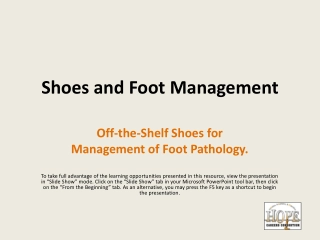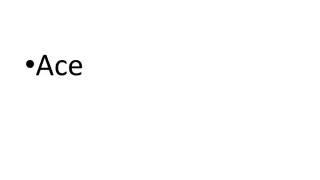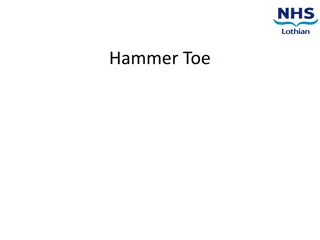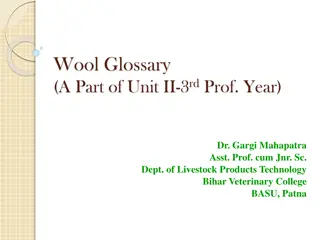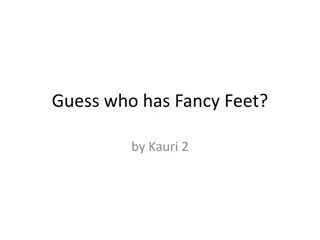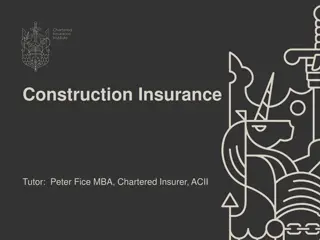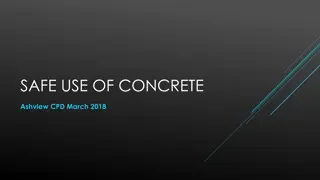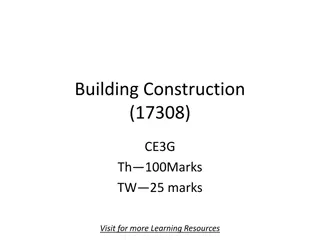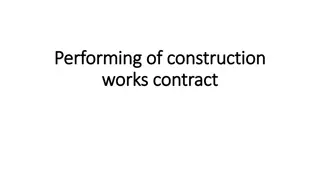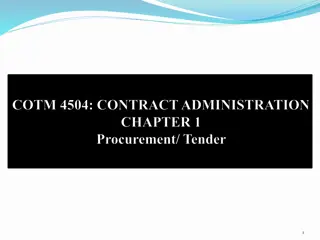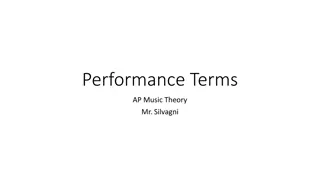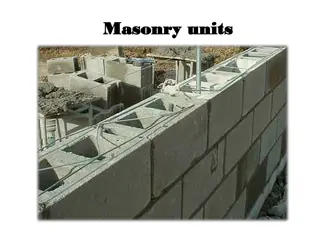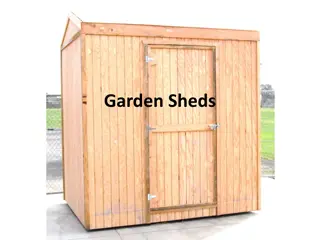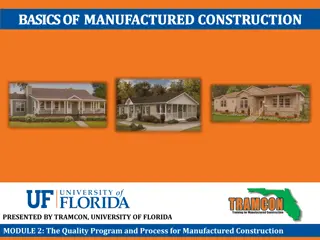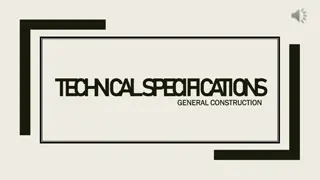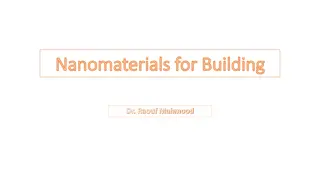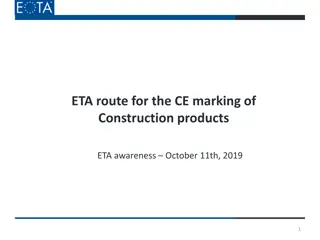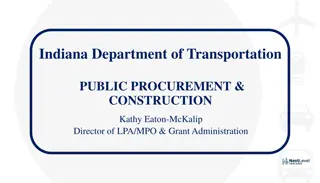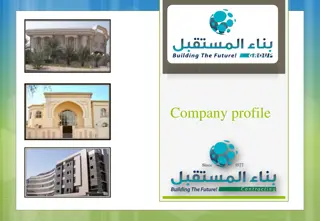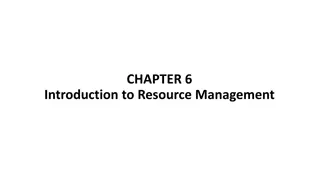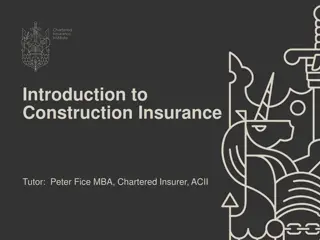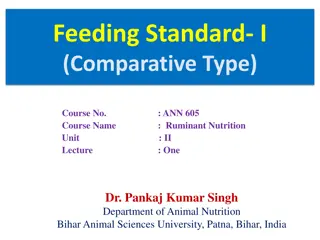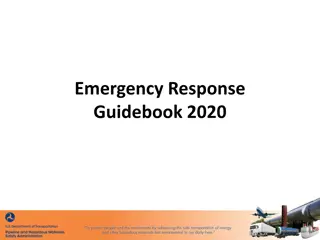Understanding Footwear: Glossary and Shoe Construction Terms
Explore the basic shoe anatomy, glossary terms, and shoe construction details in this resource. Learn about components like the sole, heel, upper, and various toe styles. Discover terms such as aglet, ankle strap, bellow tongue, and more that enhance your knowledge of footwear design and construction.
Download Presentation

Please find below an Image/Link to download the presentation.
The content on the website is provided AS IS for your information and personal use only. It may not be sold, licensed, or shared on other websites without obtaining consent from the author. Download presentation by click this link. If you encounter any issues during the download, it is possible that the publisher has removed the file from their server.
E N D
Presentation Transcript
FOOTWEAR GLOSSARY & SHOE CONSTRUCTION TERMS To take full advantage of the learning opportunities presented in this resource, Internet access is recommended. Also, view the presentation in Slide Show mode. Click on the Slide Show tab in your tool bar, then click on the From the Beginning tab. As an alternative, you may press the F5 key as a shortcut to begin the presentation.
Basic Shoe Anatomy. Sole: The part of the shoe that covers the plantar aspect of the foot. Bottom of shoe, in contact with the ground. Made from a variety of materials that cushion and protect the foot. Can be a single layer or more complex with multiple structures insole, midsole, outsole.
Basic Shoe Anatomy, continued. Heel: The bottom rear part of the shoe. Supports the heel of the foot. Upper: The part of the shoe that covers and/or encloses the dorsal, medial, lateral, and posterior aspects of the foot. May be made from a single piece of material or from a number of shaped elements, including the toe box, toe cap, vamp, tongue, quarter(s), and heel counter.
Glossary: A. Aglet: The plastic sheath at the end of a shoelace that makes the lace easier to thread through the eyelet holes of a shoe. Ankle Strap: A strap attached at the rear of the shoe that encircles the ankle. Usually features an adjustable buckle or elastic. Ankle Wrap: Straps that are meant to be wrapped around and tied around the ankle for a stylish accent. Apron Toe: A type of toe style of shoe characterized by a large overlay that covers the front of the toe and has visible edges or stitching. Arch: The high, curved part of the sole of the foot, located between the ball of the foot and the heel. This term can also refer to the raised area of the insole of the shoe for padding and support of the arch of the foot.
Glossary: B. Back Seam: The vertical seam at the back of a shoe or boot. Blucher Toe: A type of toe style of shoe characterizedby a smooth, turned stitch border around the toe area, like an apron toe style in reverse. Ball: The padded area of the foot between the big toe and the arch of the foot. Boot:A sturdy item of footwear that covers the foot, ankle, and sometimes the leg below the knee. Bellows Tongue: A shoe tongue that is attached at both the top and the sides of the shoe. Bicycle Toe: A type of toe style of shoe characterized by two stitched straight line accents, so named because of their similarity to professional bicycling shoe detailing. Boot Heel: Typically foundon boots, this is a wide, stable type of heel that usually is not very high. Bottoming: Refers to the process of attaching the sole to the upper. The basic methods of sole attachment include cementing, molding/ vulcanizing,and sewing.
Glossary: B C. Brannock Device: A device used to measure the length and width of the foot in order to ensure proper shoe fit. Cap: A type of toe style of shoe with a full toe overlay and a straight stitching line across the top part of the toe, often seen in dress shoes. Break: The natural crease created across the vamp of the shoe from everyday wear. Cemented Construction: A shoe construction in which the upper of a shoe is cemented, rather than stitched, to the sole of the shoe. Cement construction results in a lighter, more flexible shoe. Breast: The forward-facing side of the heel; the side of the heel that faces forward when the shoe is on the foot. Clog: Of ancient origin, a wood shoe, or a shoe with a heavy wood bottom. Buckle: A clasp at the end of a length of fabric or leather that joins one end of the material to the other. Collar: The piece of material stitched around the opening or rim of the shoe. The collar may sometimes be padded to add extra comfort.
Glossary: C. Combination Last: A footwear last in which the heel is two sizes smaller in width that the widest part of the shoe, producing a shoe with a narrow heel and a wide toebox. Contoured Footbed: An insole that molds to the shape of the foot. Counter: A stiff piece of material placed at the heel of a shoe between the lining and the upper is order to retain the shape of the shoe. Crepe Sole/Crepe Rubber: A type of crude natural rubber sole characterized by a crinkled texture like crepe paper. Cuff: The various band-like and folded parts of a shoe. Curing: The application of chemicals to animal hides in preparation for the tanning process. Cushioning: Padding on the insole or outsole of a shoe for added comfort and stabilization.
Glossary: D. Dressing: The application of polish or gloss to a shoe to maintain its finish and appearance. Dual Density Midsole: Seen in running shoes, a midsole that employs two different densities of cushioning foam, with denser foam where the foot would normally tend to roll. Dri-lex: A dual layered configuration composed of Hydrofil, a moisture-absorbing nylon fiber as an under layer, and a moisture-resisting outer layer knitted together.
Glossary: E. Elastic Gore: An elastic fabric panel inserted into shoes to provide stretch. Energy Return: In running and athletic shoes, it is the response after the foot strikes the ground, a sort of propulsion that helps maintain an effective gait or stride. Eyelet: A hole through which a lace is threaded; may be reinforced with a metal ring or grommet. Ethylene Vinyl Acetate (EVA): A synthetic compound used for outsoles. EVA provides cushioning to the foot and is easily shaped by heat and pressure. Eyeletting: The operation where the eyelets are attached to the upper. The machine punches and spaces the lacing holes, and feeds and sets the eyelets in proper alignment.
Glossary: F. Fair Stitch: The stitching of the welt to the midsole. Fiberboard: A material made primarily of wood pulp, which is used for counters, insoles, and heel lifts. Finish: The process by which the final appearance of a shoe is created. The finish can include the application of polish to create a high-gloss finish, or a contrasting polish to create a rub-off finish (like antiquing). Flat Heel: Shoes with a very low or no heel height. Footbed: The insole of the shoe, where the foot rests. Often removable, the footbed is contoured and provides foot positioning, comfort, and insulation. Forefoot: The area of foot between the ball and the toes. Foxing: A strip of rubber joining the upper and sole of a shoe. Typically found on canvas sneakers.
Glossary: G. Girth: The circumference of a shoe last, as measured around the ball of the foot. Gore: An elastic panel stitched into either side of a shoe s vamp in order to make it more comfortable and easier to put on and take off. Goodyear Welt: A method of shoe construction in which the insole, upper, and welt are sewed together and the welt is then stitched to the outsole so as to leave the upper surface of the insole free of tacks and stitches.
Glossary: H. Heel: Can refer to both the rear, padded area of the underside of the foot, as well as the solid part of a shoe that supports the heel cup. The standard measure for heel heights is as follows: An 8/8 (low heel) is 1 inch high; A 16/8 (medium heel) is 2 inches high; A 24/8 (high heel) is 3 inches high. Heel Types: Types of shoe heels include, but are not limited to: Louis or French Features a curved back; ranges in height from 16/8 to 24/8. Baby Louis The same shape as a Louis heel, but a 12/8 or shorter. Built Heel Created from layers of leather or fiber with contrasting tones. Continental A higher heel with a slightly curved back and flat front.
Glossary: H, continued. Heel Types, continued: Cuban A thick, stacked heel with little or no curvature and tapered at the bottom; usually medium in height. Stacked Similar to the built heel, but typically can be created from synthetic and leather materials. Often found on spectator shoes. Wedge A heel that is as wide as the shoe itself and follows the shoes contour from toe to heel. May be of any height. Heel Height: Heel height is measured on a vertical line at the breast of the heel, from the bottom surface of the sole where it meets the heel, to the floor. Heel height is measured in increments of 1/8th inches, so an 8/8 heel is one inch high. Hindfoot: The posterior/rear portion of the foot, comprising the region of the talus and calcaneus. Hidden Gore: An elastic panel at the front of a shoe that is covered by the shoe s tongue. Provides added comfort.
Glossary: I. Injection Molded Construction: A type of sole unit construction created by injecting melted polyvinyl chloride (PVC) or a similar material into the sole mold. Inseam: The hidden seam of a welted shoe holding together the welt, upper, lining, and insole. Inseaming: The stitching together of the welt, upper, lining, and insole with a heavy durable thread. Insole: The part of the shoe that the foot rests upon, usually cushioned. Insole Rib: The part of the insole that is used when stitching a Goodyear Welt. Instep: The area of the foot between the toes and the ankle, or the top front part of a shoe. Iron: A dimension used for measuring sole thickness. An iron is 1/48thinch in thickness, thus, a 6- iron sole is 1/8 inch in length.
Glossary J K. Jelly: A clear or translucent rubber-like plastic used in soles and as a filler to add cushioning. Kidd Leather: A leather made from the skin of young goats. It s very soft and mostly used for lightweight and casual footwear. Jelly Shoes: Shoes made entirely of polyvinyl chloride (PVC). Kitten Heel: A low-heeled stiletto shoe, often between 1 and 2 inches in heel height.
Glossary: L. Laces: A strip of material strung through the eyelets of a shoe in order to pull the shoe closed and adjust its girth. Leather: The hide of an animal that has been treated and tanned. Last: A metal, wood, or plastic form used to create the shape of a shoe. Each shoe last is designed for a particular heel height, toe shape, and type of footwear. Lasting: The process of pulling and shaping a shoe on a last. This can be done by pulling and tacking the upper to the last or by string lasting. Leather Upper: The bulk of the exterior of the shoe, everything except the sole and interior, made of leather rather than man-made materials. Lift: One of the several layers of leather or leather-board used to make a heel.
Glossary: L, continued. Littleway Lasting: In the Stitchdown construction, the sole stitching appears on the foot side of the insole and on the outsole bottom. The seam may sometimes be hidden in a groove on the sole s bottom to minimize abrasion of the stitching. Lug Sole: A sole with a heavy rubber sole. Lycra/Neoprene: A blend of stretch fabric and neoprene rubber, ideal for a waterproof and sporty soft lining. Lining: The inside material that touches the sides of the foot, the top of the foot, and/or the back of the heel. Linings can be made of a variety of materials. The main purpose of a lining is to cover the inside seams of a shoe, but linings made of special materials also tout comfort features such as additional padding, or the ability to pull moisture away from the foot. Loafer: A low, step-in shoe without shoelaces or buckles.
Glossary: M. Man-made: Not made from an animal. Mary Jane: A shoe with a strap across the instep that is attached with elastic, Velcro, or buckle. Midsole: The part of the shoe between the very bottom and where the foot rests. The midsole is a cushioning layer between the outsole and the insole. Various rubber and foam compounds are used for shock absorption. Generally, heavier-weight materials will be firmer and more durable. Moc Toe: A type of toe design with a seam and stitching details, originally seen in moccasins. Moccasin: A slip-on shoe with visible stitching around the perimeter of the toe box, creating a gathered effect. Monk Strap: A type of shoe designed like an oxford, but with a strap closure across the instep rather than a lace up front closure. Mules: A shoe or sandal characterized by a closed, or nearly closed, toe and a backless heel of any height.
Glossary: N. Negative Heel: Popular in comfort footwear, a type of footbed with a lowered heel area designed for more natural foot placement. Nap or Napped: A soft and/or fuzzy surface texture usually associated with leather or suede. Neutral Cushioning Shoes: Best for runners with a high arch who do not pronate effectively. These shoes do not have medial supports but are more concerned with midsole cushioning. The midsole provides the extra shock absorption that the lack of pronation is missing. Nubuck Upper: The exterior part of a shoe, excluding the sole, made of a durable high-quality cow hide which has been treated to give it a suede or velvet-like texture.
Glossary: O. Orthosis: A support, brace, or splint used to support, align, prevent, or correct the function of movable parts of the body. Shoe inserts are orthoses that are intended to correct an abnormal or irregular walking pattern by altering slightly the angles at which the foot strikes a walking or running surface. Overlay: Detailing on a shoe made by layering material on top of other material. Oxford: A type of shoe characterized by shoelace eyelets tabs that are attached under the vamp, a feature termed closed lacing. This contrasts with Derbys, or Bluchers, which have shoelace eyelets attached to the top of the vamp. Outsole (or Sole): The very bottom of the shoe, the part that contacts the ground. Outsoles can be made of a variety of materials.
Glossary: P. Perforation: A pattern of small holes punched or bored into the trim of a shoe, for the purpose of decoration or ventilation. Polyurethane (PU): A type of man-made material that can be made to have the look and feel of leather. Piping: A decorative, narrow strip of leather or synthetic that follows the seam of a shoe. Polyvinyl Chloride (PVC): A semi-rigid plastic material, often used in heel counters and outsoles for added support. Pitch: The angle of the back part of the heel where it meets the sole, compared to the front part of the heel where it meets the sole. On a high-heeled shoe, the pitch should be at a large angle in order to stabilize the heel. Peep Toe: A shoe with a narrow opening in the front that exposes the toes. Platform: A high-heeled shoe with a thick sole under the front part of the foot. Pumps: Women s dress shoes that are typically characterized by a medium or high heel. Styles are typically completely enclosed.
Glossary: Q - R. Quarter: The rear portion of a shoe comprising the part that covers the heel and is often joined at the back seam. Rand: Thin rubber bindings that run around the junction of the upper and sole and part way up the boot. Rands add to a boot s overall waterproofing and protect the upper from abrasion. Quarter Panel: The sides of the shoe from the heel to the toe. Quarter Lining: The lining of the rear part of a shoe, typically made from leather or fabric. Rim: Another term to describe the portion of shoe where the foot enters, also known as the collar or topline. Rocker: The curvature of the sole from the heel to the toe of a boot to facilitate walking. Ruched: A type of detailing characterized by gathered or pleated material with stitching accents.
Glossary: S. Scalloped: A type of detailing characterized by round wavy edges. Scree Collar: Lightly padded cuff at the top of the upper that keeps out debris. Sculpted Heel: A type of high heel molded in one piece, usually out of high-impact plastic. Sockliner: A thin piece of material that is laid on top of the insole in the interior of the shoe. Seat: The part of the shoe directly below where the heel of the foot rests. Also where the sole and the heel are joined together. Shaft Height: The measurement of the shaft of the boot. Measurement is from the inside seam where instep and sole meet to the top of the boot. Sole (or Outsole): The underside of the shoe. The term is also used to describe the bottom of the foot.
Glossary: S, continued. Shank: The supportive part of the shoe connecting the heel and the wide part of the sole. It sits under the arch of the foot and gives the shoe structure. Shoe Sizes: An alphanumerical indication of the fitting size of a shoe. The variation between full sizes is one- third of an inch, while the difference between half sizes and full sizes is one- sixth of an inch. Suede: A type of leather with a napped surface, but may also indicate fabrics of a similar nap or brushed finish. Silicone: A slippery polymeric material used to waterproof shoes. Sandal: An exposed shoe style that includes an open toe and open back. Slips on and is held in place with leather or fabric straps across the foot.
Glossary: S, continued. Shoe Width: The width of a shoe is typically measured in letters such as AAA, AA, A, B, C, D, E, EE, EEE, and EEEE, 4A, 3A, 2A, A, B, C, D, E, 2E, 3E, 4E, 5E, and 6E, or N (narrow), M (medium) or R (regular), W (wide). These letters refer to the width of the shoe as measured at the ball of the foot. Widths are defined in one-sixths of an inch. Slingback: A backless shoe that is held in place with a strap at the back of the foot. The strap is typically elastic or buckled for adjustment. Sneaker: A rubber-soled casual shoe made of soft, often man-made, materials, and used often for casual wear and sporting events. Stiletto: A very thin, very high-heeled shoe, the heel of which tapers nearly to a point where it comes into contact with the ground. Stitchdown: The stitching of the outward- turned lower edge of a shoe upper directly to the sole or sometimes with a welt added over the edge. Sheepskin: A type of material used to make shoes and boots made from the leather of sheephide. Comes with or without the wool attached.
Glossary: S, continued. Synthetic Materials: Materials that are man- made and not naturally produced. Combinations of synthetic materials in a shoe allow for breathing room and cushion the foot. Plastic materials such as ethylene vinyl acetate (EVA), liquid silicone, or a polyurethane foam give runners and athletes flexible stability in the soles of exercise shoes. A nylon mesh material creates the upper and lining structures of shoes. Rubber and polymer material designs can be made to look like leather and can provide waterproof protection. Slip Lasting: Where the sock lining is stitched to the upper prior to inserting the last giving the upper a partial shaping. After the upper and sock lining have been stitched together, the platform cover is sewn to this unit. The sole is then attached and finished in the same way as other shoes using the cement attaching process. String Lasting: The process of serging a string or tape to the lower edge of the upper so once the upper is placed on the last, the string can be pulled tight helping to form the upper on the last prior to bottoming operations. Straight Lasted: A type of last used to create a very straight shoe that helps to prevent severe pronation.
Glossary: T. Thermostatic: Maintains or has an unchanging temperature. Throat: The main openingof a shoe extending from the vamp to the ankle. Thermoplastic Rubber (TPR): A plastic material used by many manufacturers in the injection molding process. Tip: An additional piece of leather covering the toe of a shoe. May be in several different shapes or patterns. Also known as a cap. Thermoplastic Urethane (TPU): A plastic material that gives support through the midfoot or medial side of a running shoe. Toe Ridge: A horizontal ridge added into the footbedof some sandals to anchor and provide support and cushioningfor the toes. Tongue: Strip of leather or other material sewn into the vamp of the shoe extending to the main opening. Provides paddingfor the top of the foot; asymmetric tongues add support and comfort. Topline: The openingin the upper through which the foot enters. To reinforce the top line, an adhesive-coated fabric tape is often applied to the upper near the top edge.
Glossary: U V. Upper: The upper part of the shoe that encases the foot from heel to toe but does not include the sole. Uppers come in a variety of styles, some made from leather, fabric, or synthetics. Unit Bottom: A single shoe bottom made from a mold of rubber or plastic. It includes the sole, platform heel, or wedge. Vamp: The front center part of a shoe s upper. Vinyl: Short for polyvinyl chloride (PVC), vinyl is a shiny plastic often used for coating shoes. Vulcanizing: The process where a thermoplastic or rubber sole is joined to the upper using heat. Vulcanized Rubber: Rubber that has been converted from its crude state to one of durability and strength.
Glossary: W. Welt: A strip of leather sewn between the insole and the outsole to create greater durability. Width: The width of a shoe is typically measured in letters (AAA, AA, A, B, C, D, E, EEE, EEEE) and refers to the width of the shoe as measured at the ball of the foot. Widths are defined in one-sixths of an inch. Wedge Heel: A heel that extends from the back of the shoe to the ball of the shoe, following its contour. Waist: The part of the foot or shoe located between the ball and the instep. The shank reinforces the waist of the shoe and prevents it from collapsing or distorting in wear. This concludes the Glossary Section. There are no X, Y, or Z sections.
Review. PURPOSE: A shoe fills many roles mainly, it should provide protection, be comfortable, enable functional performance, promote foot health, and satisfy a user s esthetic. SECTIONS: A shoe s primary sections are comprised of the quarter, vamp, throat, shank, heel seat, toe box, and topline. PATTERNS: This is the form by which the various parts of the upper are cut. OUTSOLE: This is the most basic part of the shoe. Up until the late 1940s, almost all conventional shoes had leather soles. Today, the great majority are made with non-leather soles, consisting of a wide variety of materials.
Review, continued. OUTSOLE MATERIALS: Thermoplastic (TPR) Rubber: Thermoplastic refers to a plastic softened under heat, set in a mold, then allowed to harden. Soles of this material are lightweight, durable, flexible, skid-resistant and have good esthetics and can be made to look like leather. Urethanes (Polyurethanes): This man-made material is also lightweight, durable, flexible, resilient, slip-resistant, and has good esthetics. Polyvinyl Chloride (PVC): This man-made material is also durable but has less esthetics than other materials. PVC is applied via a heat-molding (injection- molded) process.
Review, continued. OUTSOLE MATERIALS, continued: Rubber Compounds: Rubber-type soles are use on some sport and casual shoes, Special compounds, such as Neoprene, Nitrile, and Hypalon are used on work, outdoor and military boots because of their rugged wear. Nylon: This is a tough thermoplastic sometimes used on athletic shoes.
Review, continued. SOLE MATERIALS: Crepe: A member of the rubber family, it can be either natural or man-made. It is highly resilient but can be heavy, lose color with wear, and can be hot in warm weather. Microcellular: These are man-made, foam-type soles, such as cushion crepe. Microcellular means a blown material to create an internal network of air cells. This material makes soles resilient and lightweight. Composition: This term means any mix of materials and are commonly used on inexpensive shoes. Leather: This material is still regarded as the king of sole materials.
Review, continued. SOLE THICKNESS: Heel thickness is measured in irons. One iron equals 1/48thof an inch. INSOLE: The footbed upon which the foot directly rests is often considered the most important component of the shoe because virtually every other part of the shoe outsole, counter, box toe, linings, upper, etc. are attached to it. MIDSOLE: A small share of footwear has a midsole. While the midsole receives no direct wear, it provides an extra buffer layer under the foot for added support and comfort.
Review, continued. SHOE CONSTRUCTION: This is the manner in which the sole is attached to the upper. There are more than 800 known ways to make a shoe, but most are variations of a few basic methods. Seven of the more common shoe construction methods include Stitchdown, Goodyear Welt, Vulcanized, Cement, Sliplasted (or California), Injection Molded, and Littleway and McKay. SHOE STYLES: Of all the tens of thousands of footwear fashions introduced into the marketplace each year, there are only seven basic footwear styles: boot, clog, moccasin, mule, Oxford, pump, and sandal. TONGUE STYLES: The four most basic tongue styles are plain, Bellows, fringed, and apron. HEEL STYLES: While men s heels are largely standard in shape and height, women s heels are designed in scores of shapes and styles, including, but not limited to, Cuban, Spanish, French, Argentine, Louis, baby Louis, continental, spike, needle, setback, little, wedge, military, stacked, dutchboy, and oval.
Review, continued. HEEL HEIGHT: Heel heights are measured in eighth-inch increments. This measurement is often done from the back of the heel; however, the official way is to measure from the front (or breast) of the heel. UPPER MATERIALS: There are three basic categories of shoe upper materials: leather, man-made, and fabric. LEATHER: This is the most logical material for footwear because it is made of hide and skin and, thus, is a natural foot covering. MAN-MADE MATERIALS: Man-made materials can be divided into three categories: vinyls, urethanes, and poromerics. o Vinyls (polyvinyl chloride, or PVC) are the most commonly used of the man-made shoe upper materials. o Urethanes (polyurethanes) are essentially the same as the vinyls except that the surface coating is polyurethane. o Poromerics are the most leather-like of the man-mades in texture and esthetics.
Review, continued. UPPER MATERIALS, continued: FABRICS (or Cloth): These materials can be in natural or man-made form. Common upper fabrics include canvas, denim, satin, cotton, linen, nylon, and velvet. THE LAST: This is the mold over which the shoe is made. The word last comes from the Anglo-Saxon word laest, which means footprint or foot track. The last determines the fit and feel of the shoe on the foot and bears much influence on the shoe s wear performance (tread, balance, shape-holding ability, etc.). It is the prime ingredient of the shoe s look for fashion character. For many centuries, lasts were made of wood. In the 1960s, the plastic last was introduced and today most lasts are of this type.
Diabetic / Therapeutic Shoes. Diabetic, or therapeutic, shoes are specially designed shoes intended to help diabetics avoid foot injuries and improve mobility. They typically feature: Breathable construction; Design that is deeper and wider than regular shoes; No interior seams; Roomy toe box; Easy, adjustable fit. They are equipped with a removable orthosis, which could include an insert, arch support, or shoe filler.
Diabetic / Therapeutic Shoes, continued. Features / Benefits: Adjustable Closure: Allows for different foot needs, even throughout the day; no-tie straps or Velcro closures are options. Wide Toe Box: Keeps toes from rubbing against each other; helps prevent the development of deformities. Forgiving Material: Prevents friction especially if the foot tends to swell which may cause blisters; leather and microfiber expand. Wide Footbed: Takes pressure off areas that may be prone to calluses; enables space for shock-absorbing materials and/or space for inserts. Extra Deep: Provides support around the ankle, giving it more stability; gives foot deformities, such as bunions and hammer toes, the space they need; provides room for an insert or orthosis.
Footwear Glossary & Shoe Construction Terms. This workforce product was funded by a grant awarded by the U.S. Department of Labor s Employment and Training Administration. The product was created by the grantee and does not necessarily reflect the official position of the U.S. Department of Labor. The U.S. Department of Labor makes no guarantees, warranties, or assurances of any kind, express or implied, with respect to such information, including any information on linked sites and including, but not limited to, accuracy of the information or its completeness, timeliness, usefulness, adequacy, continued availability, or ownership. Produced 2016. HOPE Careers Consortium is a partnership of five institutions of higher education that is building exciting new programs that will provide valuable career education and training in the Orthotics, Prosthetics, and Pedorthics (O&P) sector. The five institutions are: Baker College Flint, Michigan; Century College White Bear Lake, Minnesota; Oklahoma State University Institute of Technology Okmulgee, Oklahoma; Spokane Falls Community College Spokane, Washington; and St. Petersburg College St. Petersburg, Florida. Although the authoring institution of this educational resource has made every effort to ensure that the information presented is correct, the institution assumes no liability to any party for any loss, damage, or disruption caused by errors or omissions. This work by Oklahoma State University Institute of Technology (OSUIT) is licensed under the Creative Commons Attribution 4.0 International License. To view a copy of this license, click on the following link: Creative Commons Licenses 4.0.


